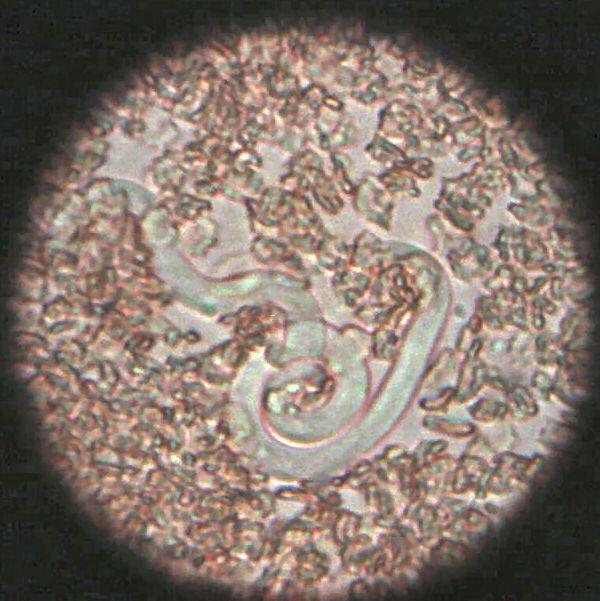I’ll kick this entry off with some good news: heartworms are rare in the Willamette Valley area, and in the Pacific Northwest in general. More good news: heartworms are most commonly transmitted in warmer months, March or April through September or October, so we’re not currently in “heartworm season.”
But that’s about as far as the good news goes. Heartworms are nasty little things, and the fact that they’re rare in this area or rare during this time of year does not mean that they shouldn’t be taken very seriously. Advanced heartworm infections in dogs can lead to severe weight loss, respiratory difficulties, hemoptysis (coughing up blood), and eventually congestive heart failure.
The reason heartworms are rare in cold months is because they live out part of their lives in the guts of mosquitoes, and can only survive above certain temperatures (about 57 °F). The reason they’re rare in the Pacific Northwest is, generally, because there’s a much less dense mosquito population here than in, say, the swampy, hot, and humid deep south. However, any Portlander who frequents hiking trails or camp sites can attest to the fact that mosquitoes are anything but absent from the region, and some mosquitoes do manage to find their ways indoors. So, while rare given the area and time of year, the risks associated with heartworm are still worth taking preventative measures.
A heartworm begins its life as a microscopic, live-born worm, birthed by an adult worm in a host’s pulmonary artery. It is circulated in the host’s bloodstream until a mosquito ingests it through the skin. After hanging out in the mosquito’s digestive tract for a while, it then makes its way to the bug’s salivary glands, where it’s able to enter a new host’s bloodstream during the biting process. There, it takes several months to grow in size and eventually find its way, via blood flow, to the new host’s pulmonary artery, where it settles and can grow to nearly 30 cm in size, affecting a dog’s circulation and breathing.
A heartworm begins its life as a microscopic, live-born worm, birthed by an adult worm in a host’s pulmonary artery. It is circulated in the host’s bloodstream until a mosquito ingests it through the skin. After hanging out in the mosquito’s digestive tract for a while, it then makes its way to the bug’s salivary glands, where it’s able to enter a new host’s bloodstream during the biting process. There, it takes several months to grow in size and eventually find its way, via blood flow, to the new host’s pulmonary artery, where it settles and can grow to nearly 30 cm in size, affecting a dog’s circulation and breathing.
While not common in cats, heartworms will occasionally target a cat as a host. Or, rather, a heartworm or two will: because cats are not heartworms’ ideal hosts, very few tend to end up inside of them, and even fewer survive to adulthood. Since the most commonly used heartworm blood test is only sensitive to antigens given off into a cat’s blood by adult female heartworms, a cat that only has a few worms (and therefore an increased chance of having all male worms) may test negative for infection even though he has an advanced case.
So, as with all parasites, the best way to treat either a cat or a dog is with preventative care. Most companies that manufacture parasite preventatives have some sort of “all-in-one” product. For dogs, Sentinel and Trifexis both work against fleas, heartworms, and several intestinal parasites. For cats, Revolution deals with all of those issues as well as ear mites (see our previous entry for info on them). It’s especially true that “prevention is the best medicine” in the case of heartworms, because it’s possible that killing the thousands of microscopic heartworms in a heartworm-positive dog’s bloodstream could cause the patient to go into shock, maybe even resulting in death. Besides, adult heartworms can’t be killed or dislodged with these misleadingly-named “heartworm drugs,” which only function as preventatives against the newborn parasites.
Veterinarians test for heartworm by dropping a blood sample onto a reactive chemical test: the whole process only takes ten or fifteen minutes. For cats, heartworm tests are often included as part of the viral testing regimen used to check for FIV and Feline Leukemia (more on both of those in future entries), which is a test that Linwood strongly recommends for our clients’ new cats. To schedule a heartworm test and to talk to one of our doctors about the risks of infection and benefits of prevention, please feel free to contact us via telephone or e-mail.

No comments:
Post a Comment